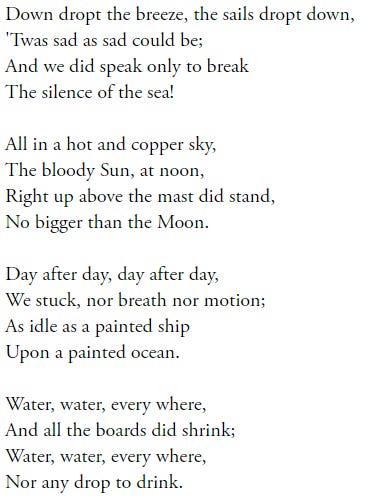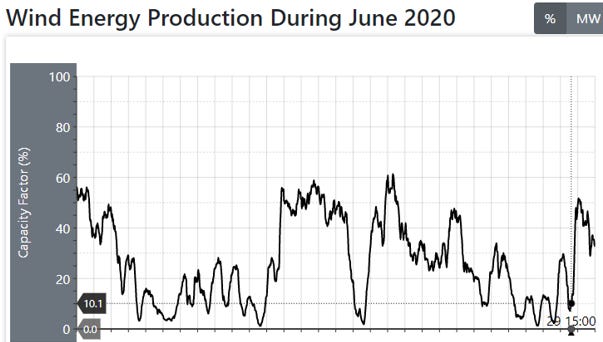Watch from minute 38 on.
Thesplendid journal Quadrant Online is a wellspring of wisdom. From the 6 July2024 edition, here is an insightful article by Rafe Champion. Share this valuablematerial everywhere.
Jul 6
Sincere thanks to manyreaders who helpfully forward to friends the Michael Darby in Australia substack. Instead of forwarding, please SHARE THIS LINK TO THIS SUBSTACK. The link saves on data transmission and allows the recipients to see corrections and updates.
Rafe Champion writes (Quadrant online):
Severe wind droughts areprolonged spells with next to no wind across continental areas.ey also existoshore as any sailor who has been becalmed knows full well.Wind droughts willkill the green-power fantasy, and they have the potential to deal a massive blowto our lifestyle, depending as we do on abundant, reliable and aordable power.While meteorologists don ’t mention them, independent Australian observersdiscovered wind droughts over a decade ago but nobody took any notice. We maypay a bitter price for this neglect.
Serious questions have tobe asked about the silence of meteorologists on wind droughts. At the same timethe responsible authorities should be called to account for their failure tocheck the wind supply before connecting intermittent energy to the grid.
Why wind won’t work
Wind and solar cannotprovide reliable power at grid-scale and the reason is as simple as ABC: Inputto the grid must continuously match the demand, and the continuity of wind andsolar input fails on nights with little or no wind.
The amount of storagerequired to bridge the gaps is not feasible or affordable.
Supporters of thetransition to intermittent energy invoke a “holy trinity ” of strategies toride through wind drought. These are (1) long-distance transmission lines toshift power from areas of plenty to drought zones, (2) pumped hydro storage,and (3) battery storage.
Longdistance transmission lines willnot help because wind droughts can extend across the whole of SE Australia. Onthe other side of the world they have been known to extend across all ofwestern Europe.
Pumpedhydro at the scale required appearsto be out of the question.There is nosubstantial pumped hydro scheme in the world that runs on wind and solar poweralone.
Asfor batteries, we read practicallyevery day that more “big batteries ” are coming but “big ”is an abuse oflanguage in this context because the capacity of even the biggest batteries,like the 1.4GWh Waratah Super Battery in NSW, is negligible compared with thepower required in a single night in the grid. That is in the order of 300GWh,while the total capacity of all the battery projects in the pipeline amount tosome 60GWh and the batteries at work in the system at present can deliver only3GWh.
The plan devised by themarket operator (AEMO) calls for a ninefold increase in the amount of installedwind and solar capacity, but all that capacity will deliver a pitifully smallamount of power on nights with little or no wind. Such nights are the limitingfactor for the whole system like the slowest ship in a convoy or weakest linkin a chain.
The threat of winddroughts
Subsidised and mandatedintermittent energy providers drive out conventional power plants because theycan make money when the market price is too low for conventional providers torun protably. The unreliables can displace conventionalpower but they can ’t replace it! Eventually there will not be enough reliable(dispatchable) power to meet 100 per cent of the demand. At that point, thepower supply will be compromised whenever the wind is low overnight.
The day of reckoning hasbeen delayed by the modest increase in demand in recent years due to creepingdeindustrialization — directly caused by the increasing cost of power. As thecoal generating capacity runs down, the pinch will first occur for a few hoursat the dinnertime peak of demand. That can be met using the deceptively namedReliability and Emergency Reserve Trader Scheme (RETS). This sounds like areserve supply, but it functions by diverting power from major users (withcompensation) to protect the integrity of the grid and avoid inconvenience forthe community at large. In other words, industrial production stops to help thecommunity’s lights stay on!
If the RETS diversions ofsupply is not enough, rolling blackouts can be organized to handle theshortfall. As the process goes on, there will eventually not be enoughconventional power to service the base load, the minimum that is required dayand night. At that point, whenever the wind is low overnight there will beblackouts, and we will officially achieve the status of a Third World country.
Since 2012, 12 coal powerstations have closed in South-Eastern Australia, taking out some 8GW ofcapacity, which in total is down to 22GW. We are now only one coal stationclosure away from a power crisis whenever the wind is low overnight. Theproblem surfaced in June 2022 when outages in some coal stations created acrisis that was met by using gas, which spiked the price of gas, and hence thewholesale price of power.
This was seen as a problemwith the price of gas, to be solved by government intervention and a price cap.It should have been seen as an early warning of what was coming if the capacityof coal power continued to run down. Gas is too expensive to be used outsidepeak periods. In addition, there are serious concerns about the availability ofgas going forward.
Energy realists know thatwe will have to burn coal for many years, yet the state of Victoria hasambitious plans to get rid of coal while they also have condential deals withtwo power stations to maintain supply. Similarly the biggest coal plant in thecountry, Eraring in NSW, will continue with publicly funded life support beyondthe scheduled closing date next year.
A worldwide menace
It is not entirelyfacetious to suggest that wind droughts could undermine Western civilization,or at least the way of life that depends on a continuous supply of aordableelectric power. As noted above, as wind and solar power displace reliable,conventional coal-fired power, a time will come when there is not enoughconventional power to meet the demand. ie., when the sun and wind are off duty.Germany and Great Britain have reached that point, and they survive with thehelp of imported power, while they shed power-intensive industries. In short,they bet the farm on wind power and lost.
The same problem is loomingwherever net zero strategies are in place. Texas had a critical situation inFeb 2021 although in that instance the wind and solar enthusiasts could pointout that the gas system was also disrupted by the cold conditions. Subsequentlythe gas supply has been winterized to the standard of the colder northernstates so it will perform in future.In contrast, there is nothing people can doto prevent windless nights.
The power authorities insome 19 US states have signalled there will be grave problems with reliabilityin the power supply in as little as three or four years if EPA regulations andthe incentives to deliver unreliable wind and solar power continue to drive outfossil fuel.
To meteorologists,silence is golden
Questions have to be askedabout the failure of the meteorologist to issue wind drought warnings whichcould and should have averted the connection of subsidised intermittent energyto the grid.
Meteorologists are theofficial custodians of weather records around the world but the customarymetric for wind resources is the average wind velocity which of course hidesboth the low and the high points, each of which are unsuitable for powergeneration from wind turbines. Official meteorological records are still notreporting low wind periods in the way that they report every other kind ofextreme weather.
Wind droughts had a low profileafter the doldrums in sub-tropical latitudes ceased to be a concern whensteamers replaced ships under sail. Even the prolonged European Dunkelautes (still and dark periods) did not arouse attention untilthey precipitated the crisis in the power supply in 2021, when the cost ofpower in Britain and Germany surged, even before the war in Ukraine furtheraggravated the situation.
An entry for Dunkelautes only appeared in Wikipedia in October 2020 althoughmariners at sea must have known them from time immemorial and millers on landmust have experienced them for centuries. H G Wells wrote in 1901 thatwindmills were not suitable for pumping water from coal mines because “ a gangmight sit at a pithead for a month, whistling for a gale. ”
Apparently some people wereaware of wind droughts a hundred years ago and it remains to be seen how themeteorologists explain their silence on the matter. As for oshore winddevelopments, perhaps those who approve such projects should read Coleridge’s“The Rime of the Ancient Mariner ” .
Australians led the worldin wind-watching. Over a decade ago, Anton Lang and Paul Miskelly clearlyidentified the danger of wind droughts in Australia, but their work escaped theattention of the responsible authorities and is still virtually unknown.
They used the AEMO recordsof continuous wind power generation to decisively refute the view thatAustralia has superb wind resources, which had been accepted in officialcircles, based on the average wind speeds reported by the local Bureau ofMeteorology and the conclusions of numerous academic studies.
The landmark paper appeared here in 2012.
During calendar year 2010the total wind output across the grid fell rapidly to zero or near zero on 109occasions in the year. These low wind periods (not yet called wind droughts)occurred when high-pressure systems fell over most of the continent, movingfrom west to east as shown on the weather maps displayed in the newspaper andTV weather reports.
In 2010 there were only 23wind farms and less than 2GW of installed capacity. Hopes were high that thesupply would become more reliable as sites became more numerous and widespread.This is not happening, with over 11GW installed, and the records show thatprolonged wind droughts still occur across SE Australia, most recently forthree days in August 2023.
Lang was an RAAFelectrician in 2008, when he rst started to report his observations on aprivate blog. His posts are still appearing regularly and there are now severalthousand posts on various aspects of the performance of the wind fleet and theother sources of power as well. This is a remarkable achievement and it must be one of themost sustained, singlehanded, unfunded research projects on record.
LINK TO PA PUNDITS INTERNATIONAL displaying the work ofAnton Lang posted by TonyfromOz
ITS ALL OVER FOR WINDAND SOLAR ON THE GRID
Wind droughts happen allover the world and they are a fatal impediment to the net zero program.
Given the failure of theocial meteorologists to issue warnings, there is a need for two high-levelinquires. One should aim to discover why the officials never warned the publicor the responsible authorities about the fatal threat to the power supply.
Was it incompetence,negligence or something else? That inquiry should be replicated in all thecountries with official meteorological offices and it should extend to theWorld Meteorological Organizer that was a foundation member of the climatealarmists club.
The other inquiry inAustralia would aim to identify the agencies that failed to conduct due diligence on thewind supply before wind andsolar power were allowed to connect to the grid.
[Clickon the graphic below for the linkto Rafe Champion’s 16 July 2020 Quadrant Online article: No Gusts, No Glory.]
Imagine building theinfrastructure for a massive irrigation project without an exhaustive study ofthe water supply, including all the available rainfall records.
Rafe Champion’spowerful conclusion
In the absence of duediligence, tens of billions of dollars have been added to the national debt toallow subsidised and mandated intermittent energy to enfeeble the grid in oneof the most costly policy blunders in peacetime.In return for the expense wehave got less reliable and more expensive energy, causing domestic hardship anda great deal of unrecorded deindustrialisation. At the same time there has beenmassive environmental damage and division in regional communities.
Inshort, there has been a colossal negative return with an enormous threat to thenation’s security and prosperity.
Well said by RafeChampion!
- Forums
- Political Debate
- Australia's Nuclear Future
Watch from minute 38 on.Thesplendid journal Quadrant Online is a...
-
- There are more pages in this discussion • 283 more messages in this thread...
You’re viewing a single post only. To view the entire thread just sign in or Join Now (FREE)







